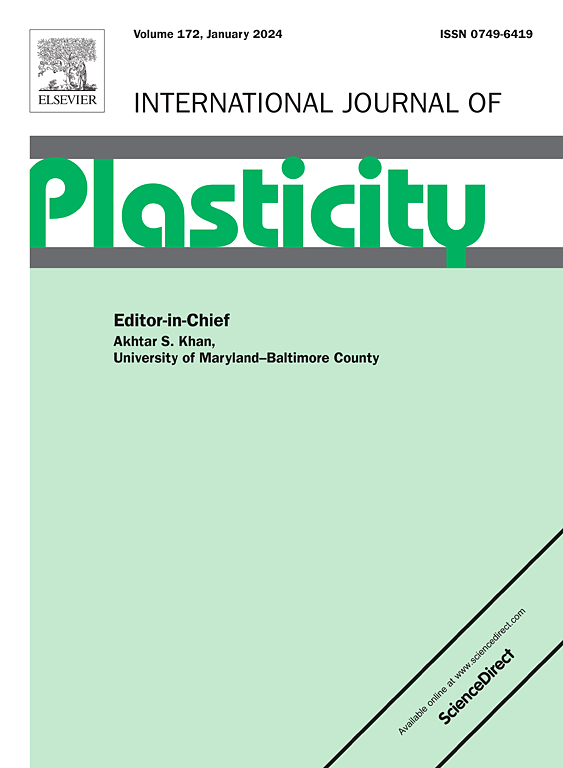Simultaneously enhancing room-temperature strength-ductility synergy and high-temperature performance of titanium matrix composites via building a unique bimodal architecture with multi-scale reinforcements
IF 9.4
1区 材料科学
Q1 ENGINEERING, MECHANICAL
引用次数: 0
Abstract
To meeting the double demands of structural weight reduction and performance improvement of aerospace vehicle, conventional high-temperature titanium alloys or titanium matrix composites (TMCs) are encountering a huge challenge that the room-temperature ductility will be inevitably deteriorated in pursuit of enhancing the elevated high-temperature strength. The present work proposes a feasible strategy for resolving this contradiction by constructing a novel bimodal architecture and introducing the multiscale reinforcements of microsized TiB whiskers and micro/nanosized Y2O3 particles. The unique bimodal microstructure consists of primary microsized αp/β lath clusters and micro/nano basketweave-like structure composing of αp, secondary nanosized αs and β laths. It is noteworthy that the bimodal (TiB+Y2O3)/Ti composite exhibits excellent mechanical properties with the ultimate tensile strength (UTS) of 1318 MPa with the total elongation to failure (EL) of 10.5 % at room temperature, and UTS of 934 MPa with EL of 23 % at 600 °C, far higher that of the reported 600 °C high temperature titanium alloys or TMCs. In-situ investigations indicate the postponed strain localization, the activated extra 〈c + a〉 dislocations within αp laths, and the heterogeneous deformation induced (HDI) hardening caused by the unique bimodal microstructure, synergistically promoted the ductility of bimodal (TiB+Y2O3)/Ti composite. While the strength enhancement at room temperature and 600 °C is attributed to the synergistic strengthening effect of nanosized αs, microsized TiB whiskers and micro/nanosized Y2O3 particles and HDI strengthening. These findings provide a new insight for improving mechanical properties of metal matrix composites.


通过构建具有多尺度增强的独特双峰结构,同时增强钛基复合材料的室温强度-延性协同和高温性能
为了满足航天飞行器结构减重和性能提升的双重要求,传统的高温钛合金或钛基复合材料在追求高温强度提升的同时,其室温延展性不可避免地会下降,这是一个巨大的挑战。本研究提出了一种解决这一矛盾的可行策略,即构建一种新的双峰结构,并引入微尺寸TiB晶须和微/纳米尺寸Y2O3颗粒的多尺度增强。独特的双峰结构由初级微级αp/β板条簇和由αp、次级纳米级αs和β板条组成的微纳篮状结构组成。值得注意的是,双峰(TiB+Y2O3)/Ti复合材料表现出优异的力学性能,室温下的极限拉伸强度(UTS)为1318 MPa,总断裂伸长率(EL)为10.5%;600℃下的极限拉伸强度(UTS)为934 MPa,断裂伸长率(EL)为23%,远远高于已有的600℃高温钛合金或tmc。现场研究表明,延迟应变局部化,激活额外的<;c+a>;αp板条内的位错和独特的双峰组织引起的非均质变形诱导(HDI)硬化共同促进了双峰(TiB+Y2O3)/Ti复合材料的塑性。室温和600℃时的强度增强主要是由于纳米αs、微晶须TiB和微/纳米Y2O3颗粒的协同强化作用和HDI强化。这些发现为提高金属基复合材料的力学性能提供了新的思路。
本文章由计算机程序翻译,如有差异,请以英文原文为准。
求助全文
约1分钟内获得全文
求助全文
来源期刊

International Journal of Plasticity
工程技术-材料科学:综合
CiteScore
15.30
自引率
26.50%
发文量
256
审稿时长
46 days
期刊介绍:
International Journal of Plasticity aims to present original research encompassing all facets of plastic deformation, damage, and fracture behavior in both isotropic and anisotropic solids. This includes exploring the thermodynamics of plasticity and fracture, continuum theory, and macroscopic as well as microscopic phenomena.
Topics of interest span the plastic behavior of single crystals and polycrystalline metals, ceramics, rocks, soils, composites, nanocrystalline and microelectronics materials, shape memory alloys, ferroelectric ceramics, thin films, and polymers. Additionally, the journal covers plasticity aspects of failure and fracture mechanics. Contributions involving significant experimental, numerical, or theoretical advancements that enhance the understanding of the plastic behavior of solids are particularly valued. Papers addressing the modeling of finite nonlinear elastic deformation, bearing similarities to the modeling of plastic deformation, are also welcomed.
 求助内容:
求助内容: 应助结果提醒方式:
应助结果提醒方式:


